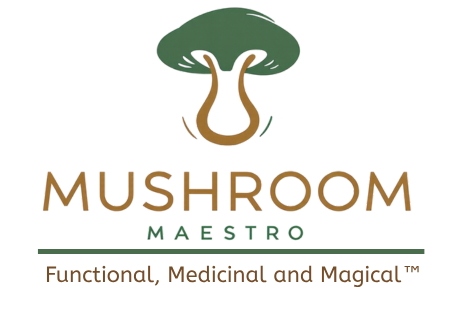Introduction: Unlocking the Brain-Boosting Power of Medicinal Mushrooms
In recent years, the rising interest in nootropics and natural remedies has ushered in a new era of health-conscious exploration, especially in the realm of cognitive enhancement. At the forefront of this movement lies the ancient yet newly appreciated world of medicinal mushrooms. These powerful fungi, once revered in traditional medicine systems such as Traditional Chinese Medicine (TCM) and Ayurveda, are now being scrutinized and celebrated by modern science for their potential to support brain health, memory function, and neurological resilience. A well-structured medicinal mushroom chart serves as an essential tool for navigating this expansive field. It offers a detailed overview of different mushrooms and their benefits, specifically targeting memory and cognitive enhancement, while providing clarity on safety, efficacy, and optimal usage.
A medicinal mushroom chart is not merely a list of names; it is a dynamic resource that connects ancient wisdom with contemporary scientific research. By consulting such a chart, individuals can make informed decisions about which mushroom supplements or whole fungi may support their unique neurological needs. Whether you’re exploring the best mushroom for inflammation or looking to enhance your memory retention naturally, understanding how to read and interpret a medicinal mushroom chart can empower you with a strategic approach to brain health. As this guide unfolds, we will delve deep into the science, practical applications, and cognitive promise of medicinal fungi, positioning this chart as a cornerstone for both beginners and experienced health enthusiasts alike.
You may also like: The Ultimate Guide to the Best Nootropic Mushrooms for Memory and Cognitive Enhancement
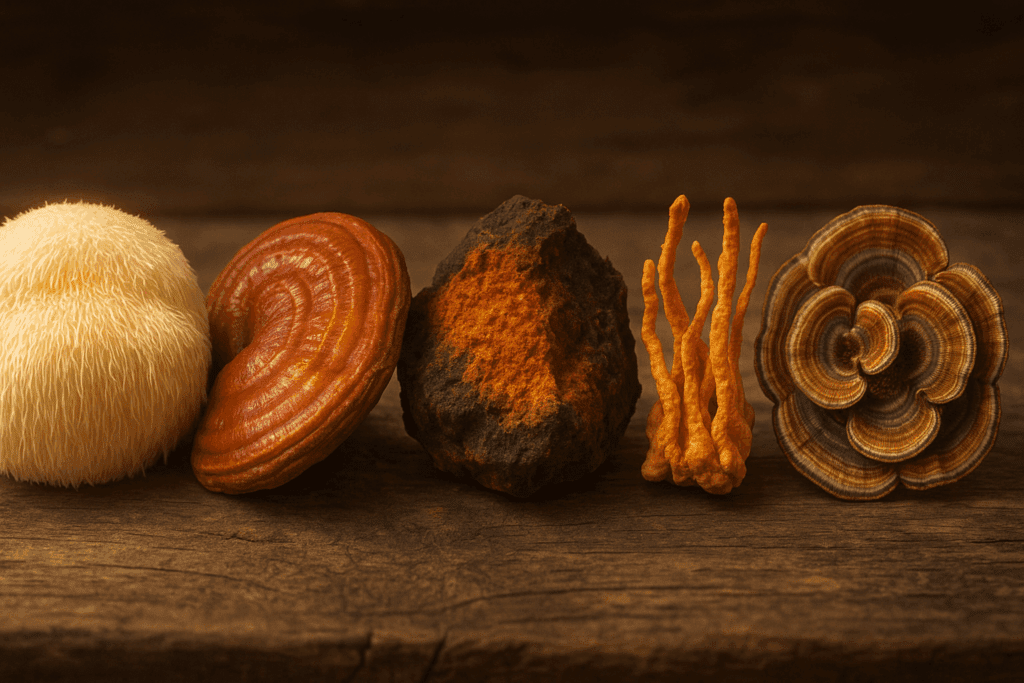
What Are Medicinal Mushrooms and Why They Matter for Brain Health
Medicinal mushrooms are a unique category of fungi known for their therapeutic bioactive compounds, such as beta-glucans, terpenoids, polysaccharides, and antioxidants. Unlike culinary mushrooms, which are primarily used for flavor and nutrition, medicinal mushrooms are prized for their adaptogenic and nootropic properties. These fungi have been shown to interact with the human body in complex ways, modulating immune responses, supporting cellular health, and enhancing neurological functions. Among the most well-known types of medicinal mushrooms are lion’s mane (Hericium erinaceus), reishi (Ganoderma lucidum), chaga (Inonotus obliquus), cordyceps (Cordyceps militaris), and turkey tail (Trametes versicolor).
In the context of brain health, medicinal mushrooms offer particularly exciting potential. For example, lion’s mane contains hericenones and erinacines—compounds that have been shown to stimulate the synthesis of nerve growth factor (NGF), a protein crucial for the maintenance, survival, and regeneration of neurons. This makes lion’s mane one of the best medicinal mushrooms for individuals looking to support memory retention, cognitive clarity, and even neurogenesis. Meanwhile, reishi and chaga serve as immune boosting mushrooms with powerful antioxidant properties that protect the brain from oxidative stress and inflammation—two key contributors to cognitive decline.
Understanding these functions helps explain why medicinal mushrooms are increasingly found in nootropic supplements and functional foods. These fungi are not just a passing trend; they are backed by centuries of traditional use and an expanding body of scientific evidence. As we continue to unravel the complex interactions between mushroom compounds and brain chemistry, medicinal mushrooms are poised to play a pivotal role in the future of integrative neurology and preventative mental health care.

How to Use a Medicinal Mushroom Chart for Maximum Cognitive Benefit
Navigating the vast world of medicinal fungi can be overwhelming, especially for those new to the practice. This is where a medicinal mushroom chart becomes indispensable. A well-designed chart categorizes different types of medicinal mushrooms based on their bioactive constituents, therapeutic functions, safety profiles, and recommended dosages. For anyone serious about cognitive and memory enhancement, this tool provides a structured framework to evaluate which mushrooms align with specific neurological goals.
For example, if your primary aim is to combat brain fog and improve mental clarity, the chart may highlight lion’s mane as a top contender due to its neuroregenerative properties. Alternatively, if stress management is your concern—a factor that significantly affects cognitive performance—reishi might be recommended for its adaptogenic effects and cortisol-regulating capabilities. By cross-referencing mushroom benefits with specific cognitive outcomes, the medicinal mushroom chart helps users create personalized supplement regimens that are both safe and effective.
Moreover, these charts often provide insights into different types of mushroom supplements, including extracts, tinctures, powders, and capsules. Each form has its own absorption profile and potency, which the chart may outline to guide user choice. For instance, dual-extract powders are often considered more effective than hot-water extracts alone, as they capture both water- and alcohol-soluble compounds. Understanding these nuances enhances your ability to choose the right supplement form, further optimizing your cognitive enhancement strategy.
Importantly, the chart also includes information about possible interactions and contraindications, making it an essential resource for those on medication or with existing health conditions. Overall, the medicinal mushroom chart serves not just as an educational tool but as a practical guide for safe and targeted brain support.
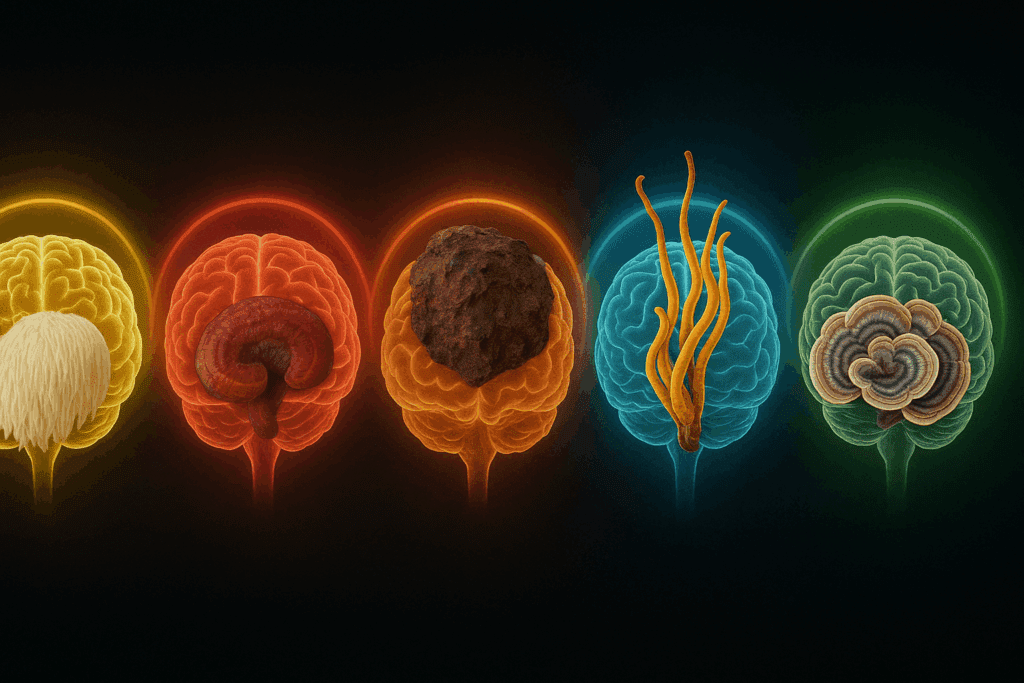
Exploring the Types of Medicinal Mushrooms and Their Cognitive Effects
A deep dive into the types of medicinal mushrooms reveals a rich tapestry of neuroenhancing potential. Each mushroom species brings its own unique profile of compounds that influence the brain and body in distinct ways. The medicinal mushroom chart becomes particularly valuable when comparing these effects side by side.
Lion’s mane remains the gold standard for cognitive enhancement due to its unparalleled ability to stimulate NGF. This makes it especially useful for individuals experiencing age-related memory decline, mild cognitive impairment, or even neurodegenerative conditions like Alzheimer’s disease. Clinical studies have demonstrated its potential to enhance memory recall, increase focus, and improve mood over sustained use.
Reishi, often referred to as the “mushroom of immortality,” is renowned for its calming effects on the nervous system. It works by modulating the hypothalamic-pituitary-adrenal (HPA) axis, thereby reducing stress hormones and promoting mental clarity. While it may not directly boost memory formation, its ability to create a more balanced mental state indirectly enhances cognitive performance.
Chaga, on the other hand, is packed with antioxidants such as superoxide dismutase (SOD) and melanin. These compounds neutralize free radicals that damage brain cells, making chaga one of the best mushrooms for anti-inflammatory effects within the central nervous system. Regular consumption can improve mental stamina, delay cognitive fatigue, and preserve long-term brain health.
Cordyceps is another fascinating entry on the medicinal fungi list. Known for enhancing mitochondrial function and oxygen utilization, it can significantly improve mental energy and alertness. This makes it particularly beneficial for students, professionals, and anyone who requires sustained mental focus throughout the day.
Turkey tail, rich in polysaccharide-K (PSK) and polysaccharide-peptide (PSP), excels in immune modulation. Though not traditionally viewed as a nootropic, its role in immune health indirectly supports cognition by reducing systemic inflammation and maintaining neurological balance. The medicinal mushroom chart brings all these factors together, making it easier to identify the top 10 best mushrooms for health according to individual needs.

Building a Personalized Brain-Boosting Routine with a Medicinal Mushroom Chart
Creating a customized nootropic regimen with the help of a medicinal mushroom chart involves more than just selecting the right species. It requires a nuanced understanding of dosage, timing, combination strategies, and lifestyle factors that influence efficacy. For optimal results, it’s important to start with a single mushroom known for its cognitive benefits, such as lion’s mane, and then gradually incorporate complementary species based on your individual health goals and tolerance.
For instance, a morning routine might include a dual-extract lion’s mane supplement to stimulate neurogenesis and sharpen focus, while an evening protocol could incorporate reishi to support stress recovery and restorative sleep. The medicinal mushroom chart can help determine whether to cycle certain fungi, how long to stay on a particular supplement, and which forms (e.g., capsules vs. teas) are most effective at different times of day.
Stacking mushrooms with other nootropics is another powerful strategy. For example, combining lion’s mane with L-theanine and caffeine has been shown to produce synergistic effects, enhancing both focus and calmness without the jitters commonly associated with stimulants. However, it’s important to consult the chart to ensure that no contraindications exist and that the combination is supported by current research.
A crucial part of building a routine is also understanding how diet, exercise, and sleep interact with medicinal mushroom supplementation. These lifestyle factors influence the body’s ability to absorb and utilize the bioactive compounds found in fungi. Therefore, a comprehensive approach that includes whole foods, regular physical activity, and proper rest will amplify the benefits indicated in the chart.
Ultimately, the medicinal mushroom chart serves as a living document—one that evolves alongside emerging research and personal experience. By keeping track of changes in cognition, mood, and energy levels, users can fine-tune their regimen for maximum brain-boosting impact.
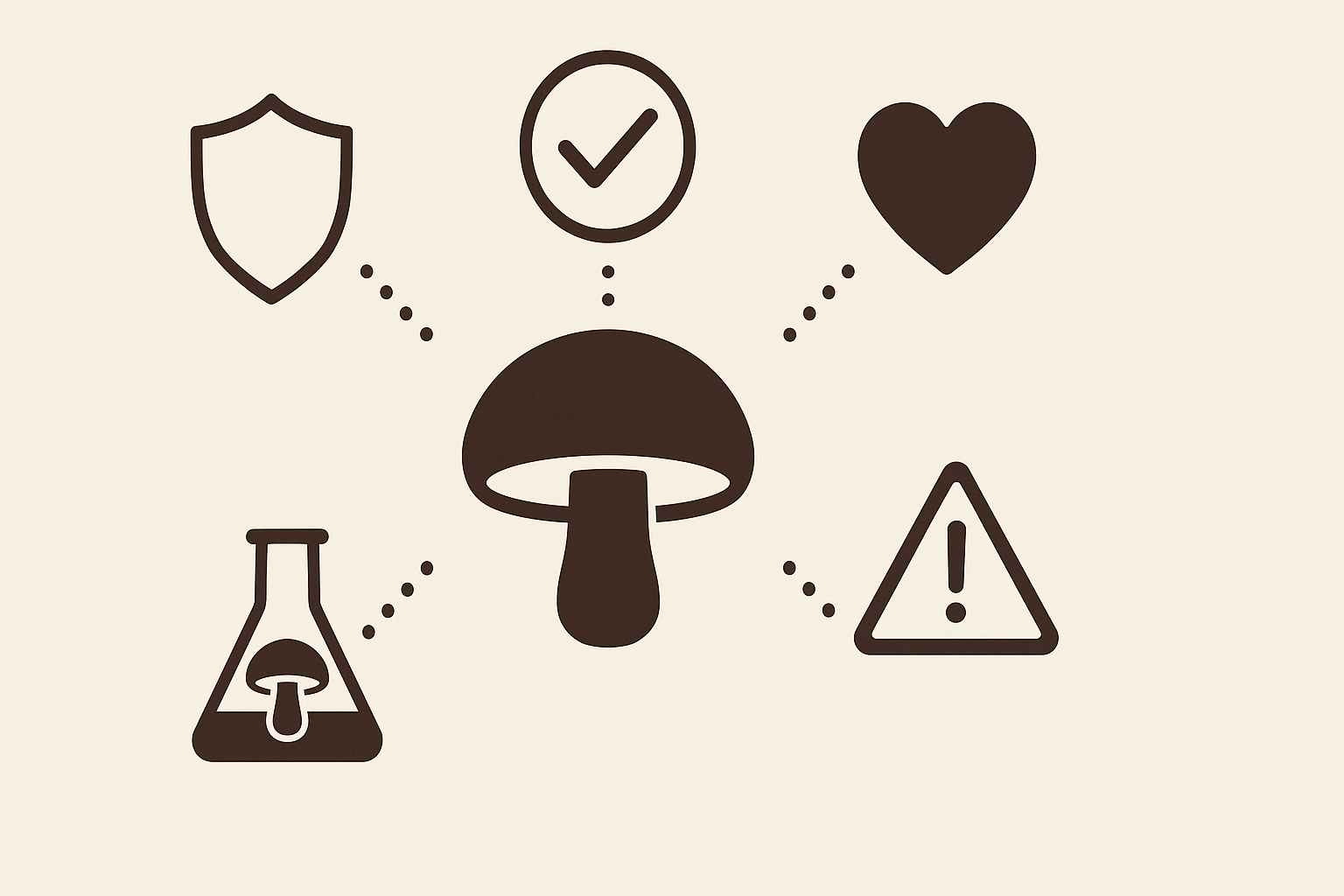
The Role of Safety: Are Functional Mushrooms Safe for Long-Term Use?
One of the most frequently asked questions about medicinal fungi is: are functional mushrooms safe for extended use? While many of these mushrooms have been consumed safely for centuries, modern users must still consider variables such as dosage, sourcing, and individual health conditions. A medicinal mushroom chart often includes a section on safety and contraindications, offering peace of mind and practical guidance.
Scientific studies have shown that functional mushrooms like lion’s mane, reishi, and chaga generally have a high safety profile when used appropriately. However, certain mushrooms may cause side effects in sensitive individuals, such as digestive discomfort or allergic reactions. Others, like reishi, may thin the blood, making them unsuitable for those on anticoagulants. The chart can flag these issues, helping users avoid adverse interactions.
Moreover, sourcing plays a critical role in safety. Mushrooms grown in contaminated environments may accumulate heavy metals or toxins, posing health risks. Therefore, choosing reputable brands that provide third-party testing and quality assurance is essential. The chart may also list trusted suppliers or include a quality checklist to help guide purchasing decisions.
Long-term safety also depends on the method of extraction. Some compounds are only bioavailable through specific processes, and poorly made supplements may offer limited benefits or potential contaminants. Understanding which extraction methods are recommended for each type of mushroom—and how those are represented on the chart—adds another layer of safety and efficacy.
By using the medicinal mushroom chart as a reference, users can make evidence-based decisions about dosage duration and sourcing, ensuring a safe and beneficial experience with these powerful natural tools for cognitive enhancement.
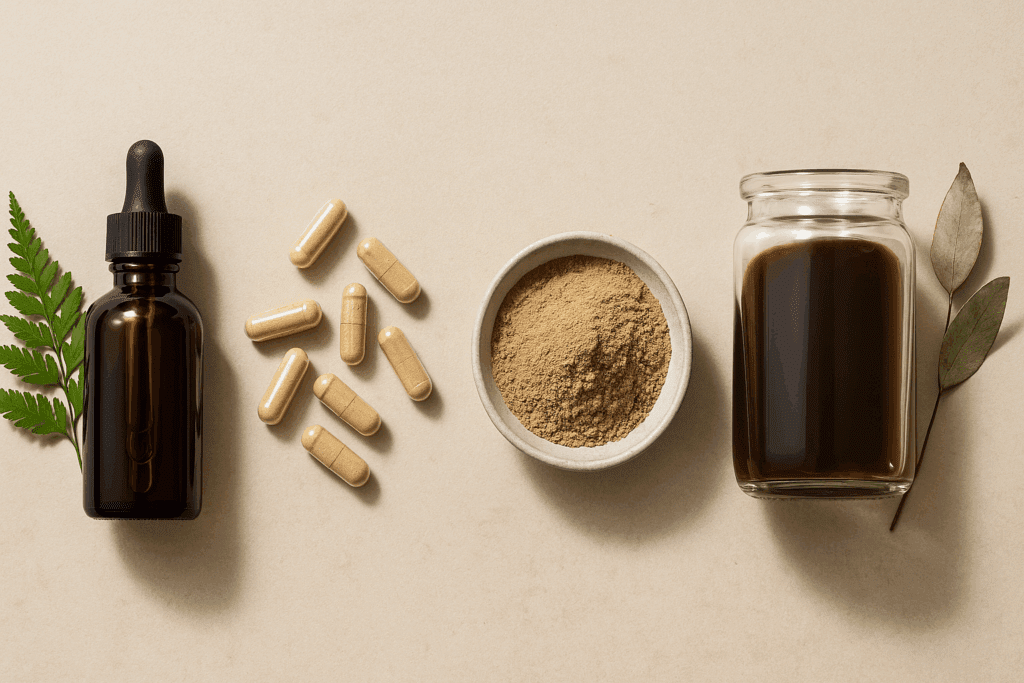
Different Types of Mushroom Supplements and Their Cognitive Advantages
When exploring the wide array of products derived from medicinal fungi, understanding the different types of mushroom supplements becomes critical. Not all mushroom products are created equal, and their effects on cognitive performance can vary widely depending on the preparation method, bioavailability, and concentration of active ingredients. The medicinal mushroom chart offers a detailed comparison of these supplement types, enabling more informed choices.
Tinctures are alcohol-based extracts that concentrate both water- and fat-soluble compounds, making them one of the most potent forms. They are ideal for mushrooms like reishi and chaga, whose triterpenoids require alcohol extraction for full efficacy. Capsules, on the other hand, offer convenience and standardized dosing, which appeals to those looking for consistency in their cognitive regimen. Powders can be easily incorporated into smoothies or coffee and are often favored for lion’s mane, which is commonly taken as a morning cognitive enhancer.
Another category worth noting is fermented mushroom supplements. Fermentation can enhance the bioavailability of certain compounds, making them easier to absorb and potentially more effective. Some products also combine multiple types of mushrooms in a single formulation, targeting a broader spectrum of benefits. The chart can help users assess whether single-species or blended formulations are better suited to their needs.
A key factor to consider is whether the supplement is derived from mycelium or fruiting body. While both parts of the mushroom have therapeutic properties, the fruiting body often contains a higher concentration of beta-glucans and other key bioactives. The medicinal mushroom chart typically distinguishes between these sources, helping users select the most potent and effective form for cognitive support.
Incorporating this level of detail into supplement selection ensures that users not only choose the right mushroom but also the right format, thereby maximizing cognitive and memory-enhancing benefits.
Integrating Medicinal Mushrooms Into Your Daily Lifestyle for Lasting Cognitive Gains
The transformative power of medicinal mushrooms does not lie solely in supplementation but in how they are holistically integrated into one’s daily lifestyle. The medicinal mushroom chart becomes particularly beneficial when used as a daily reference for incorporating specific mushrooms into meals, beverages, and wellness rituals. This integration allows for consistent dosing, improved absorption, and the cumulative benefits that arise from sustained use. For example, adding lion’s mane powder to a morning smoothie or using reishi tincture as part of an evening relaxation routine can support circadian rhythm alignment and synaptic plasticity over time.
Moreover, traditional culinary practices can be merged with modern wellness strategies to deliver dual benefits of nutrition and cognitive support. Medicinal fungi like shiitake, maitake, and cordyceps can be infused into broths or stir-fries, aligning brain-boosting compounds with a nutrient-rich diet. While not all mushrooms listed on the medicinal mushroom chart are used in cooking, understanding which are edible and which require extraction ensures safe and effective use. Fermentation and brewing methods further enhance bioavailability, especially for hard-to-digest polysaccharides and immune-boosting beta-glucans.
Engaging in mindfulness and stress-reducing habits while consuming these mushrooms may also enhance their adaptogenic effects. Mind-body synergy becomes an important concept, as a relaxed nervous system better responds to the neurotrophic properties of these fungi. The medicinal mushroom chart can even suggest optimal pairings with mindfulness practices or yoga for an integrative approach to memory and cognitive enhancement. As science continues to validate these holistic strategies, medicinal mushrooms are increasingly positioned not as supplements alone but as foundational components of an elevated daily routine.

Medicinal Mushroom Chart as a Tool for Clinical and Scientific Exploration
Beyond consumer applications, the medicinal mushroom chart is a valuable tool in clinical and academic settings. As medicinal mushrooms gain traction in the medical community, researchers and healthcare practitioners are relying more heavily on structured charts to examine pharmacological interactions, bioactive compound profiles, and therapeutic applications. These charts allow for a comparative analysis of different types of medicinal mushrooms and their neuroprotective effects, offering insights into how various compounds might interact with conventional treatments.
In clinical trials, standardized charts help document patient responses to mushroom supplementation, guiding dosage adjustments and identifying optimal delivery formats. For instance, ongoing studies involving lion’s mane and mild cognitive impairment use consistent data drawn from medicinal mushroom charts to measure memory recall improvements, NGF stimulation, and mood regulation. Similarly, reishi and turkey tail are being evaluated for their immunomodulatory effects in patients undergoing chemotherapy, with charts enabling side-by-side assessments of efficacy and tolerance.
Pharmacognosy and integrative medicine programs also incorporate medicinal mushroom charts in their curricula to teach students about botanical classification, traditional usage patterns, and modern clinical applications. By doing so, the charts bridge the gap between ethnomedicine and evidence-based practice, enriching students’ understanding of medicinal fungi as both historical remedies and future therapeutics.
Furthermore, as interest in functional foods and adaptogens continues to grow, mushroom charts are evolving into digital formats with interactive features that enable personalized filtering, real-time research integration, and AI-generated recommendations. This digital evolution represents the future of precision health, where the medicinal mushroom chart becomes not just a static reference but a dynamic interface between ancient knowledge and cutting-edge science.
FAQ :: Unlocking the Medicinal Mushroom Chart: Expert Answers to Your Top Questions
1. What makes the medicinal mushroom chart a valuable tool for everyday users?
The medicinal mushroom chart is more than a simple directory; it serves as a decision-making framework for people navigating the expanding world of mushroom-based wellness. It organizes information across multiple dimensions, including the best medicinal mushrooms for specific health outcomes, safety guidance, dosage details, and supplement formats. This visual structure helps both newcomers and experienced users distinguish between different types of mushroom supplements and make informed choices based on their unique needs. In addition, the chart can be used as a quick-reference guide to evaluate potential risks or interactions when combining medicinal fungi with pharmaceuticals or other nootropics. By streamlining complex information into an accessible format, the medicinal mushroom chart becomes an indispensable companion for anyone looking to explore functional mushrooms with confidence.
2. How do different types of mushrooms and their benefits vary across cognitive functions?
The cognitive effects of various mushrooms are as diverse as the fungi themselves. Lion’s mane is commonly praised for its role in neurogenesis and memory retention, while reishi may excel in managing stress-induced cognitive fatigue. Cordyceps offers improved oxygen utilization that helps with mental clarity, and chaga supports antioxidant defenses that protect long-term brain health. By examining the different mushrooms and their benefits within the medicinal mushroom chart, users can tailor their choices to specific mental tasks, such as focus, recall, or emotional resilience. Understanding this nuance allows for a targeted approach to cognitive enhancement rather than relying on a one-size-fits-all supplement.
3. Are functional mushrooms safe when taken with other adaptogens or nootropics?
Yes, functional mushrooms are generally safe to combine with other adaptogens and nootropics, but careful planning is required. While many people stack lion’s mane with L-theanine or ashwagandha for synergistic effects, it’s important to consider potential overlapping actions such as sedative properties or immune modulation. The medicinal mushroom chart often highlights interactions that users may overlook, such as reishi’s potential to lower blood pressure or cordyceps’ impact on adrenal hormones. Consulting a healthcare professional and using a chart to map out these relationships can reduce risks and improve outcomes. Ultimately, stacking should be personalized, based on one’s health status, goals, and the types of mushroom supplements involved.
4. What innovations are shaping the future of the medicinal mushroom chart?
The future of the medicinal mushroom chart lies in its digital transformation. Innovations include interactive charts with AI-backed personalization, app-based trackers for symptom improvement, and integration with wearable devices to measure cognitive metrics. These advancements allow users to fine-tune their use of medical mushrooms in real time. Additionally, future versions may incorporate genomic data, allowing for even more precise recommendations based on individual biology. As medicinal fungi research grows, these intelligent tools will evolve from static references into dynamic health optimization platforms.
5. What is the best mushroom for inflammation and how should it be used?
Chaga stands out as the best mushroom for inflammation due to its high antioxidant load and anti-inflammatory properties. It contains compounds like betulinic acid and superoxide dismutase, which neutralize free radicals and reduce systemic inflammation. This makes chaga especially valuable for individuals with inflammatory conditions that can impact cognitive performance, such as autoimmune disorders or chronic stress. It’s best used in dual-extract form, as both water- and alcohol-soluble compounds contribute to its effectiveness. The medicinal mushroom chart can also recommend when and how to dose chaga in relation to meals or other supplements for optimal absorption.
6. How do the types of medicinal mushrooms relate to immune and neurological synergy?
Each entry in the medicinal fungi list offers a different interaction between the immune system and the brain. Turkey tail, for example, is often listed among immune boosting mushrooms but also plays a role in reducing neuroinflammation. Reishi not only supports immune modulation but calms the nervous system by downregulating the HPA axis. The synergy between these effects can produce meaningful improvements in brain health, especially for those dealing with long-term stress or neuroimmune disorders. Charts that cross-reference immune activity with neurological outcomes are especially useful in identifying multi-functional species. This multi-axis mapping is what sets a robust medicinal mushroom chart apart from general wellness guides.
7. How do you differentiate between types of mushroom supplements for best results?
There are several types of mushroom supplements, including capsules, powders, tinctures, and fermented extracts. Each format delivers different benefits depending on the preparation method and mushroom species. For instance, reishi and chaga perform best as tinctures due to their alcohol-soluble triterpenes, while lion’s mane may be more effective in powdered or encapsulated dual-extract forms. The medicinal mushroom chart often notes the recommended form for each mushroom, guiding users toward higher bioavailability. By choosing the correct supplement type based on desired outcomes, you can amplify both absorption and therapeutic impact, which is critical when targeting cognitive and memory support.
8. What social or psychological impacts come from regular use of medicinal mushrooms?
Regular use of medicinal mushrooms often results in more than just physiological benefits; many users report psychological and social changes as well. People using lion’s mane frequently mention greater emotional resilience, improved verbal recall, and more confidence in social settings. Those taking reishi or turkey tail sometimes find it easier to manage anxiety, which leads to better interpersonal communication. These subjective benefits, while harder to quantify, are deeply meaningful and often encourage continued use. The medicinal mushroom chart, while clinical in nature, can inspire these broader lifestyle shifts by clarifying which mushrooms support emotional balance alongside cognitive function.
9. How do you determine which are the top 10 best mushrooms for health overall?
The top 10 best mushrooms for health are typically identified based on the breadth and depth of their therapeutic applications. Lion’s mane, reishi, chaga, turkey tail, cordyceps, shiitake, maitake, agarikon, blazei, and tremella frequently appear on this list. What distinguishes them is their inclusion in the medicinal mushrooms list across a wide variety of categories, such as anti-inflammatory action, immune regulation, and cognitive enhancement. However, personal context matters: the best medicinal mushrooms for one person may differ based on age, health goals, or pre-existing conditions. A well-curated medicinal mushroom chart allows for both generalized and personalized ranking, helping users identify which mushrooms are universally beneficial and which are uniquely suited to their needs.
10. What role does the medicinal mushroom chart play in understanding the medicinal fungi list more deeply?
The medicinal mushroom chart is the key to decoding the broader medicinal fungi list. Rather than viewing the list as a simple enumeration of names, the chart categorizes mushrooms by function, bioactive compounds, therapeutic areas, and research status. This layered approach gives deeper insight into the mechanisms behind each mushroom’s efficacy. For example, it allows users to compare beta-glucan content or antioxidant levels across species, providing a scientific rationale for their use. With this expanded lens, the chart becomes a gateway to both everyday use and advanced inquiry into types of mushrooms and their benefits.
Conclusion: Empowering Brain Health Through the Medicinal Mushroom Chart
The exploration of medicinal mushrooms for cognitive and memory support is no longer the domain of fringe wellness enthusiasts; it is a scientifically grounded, increasingly mainstream strategy for enhancing brain function and long-term neurological health. From lion’s mane’s role in neurogenesis to reishi’s stress-modulating capabilities, and from chaga’s antioxidant protection to cordyceps’ mitochondrial benefits, the landscape of medicinal fungi is rich, diverse, and full of potential.
At the heart of this exploration is the medicinal mushroom chart—a transformative tool that synthesizes centuries of traditional knowledge and decades of modern research into a practical, accessible format. It provides clarity amidst complexity, enabling users to compare different mushrooms and their benefits, understand safety considerations, and personalize their nootropic strategies with confidence. For those seeking the best mushroom for anti-inflammatory effects, the top 10 best mushrooms for health, or simply a trustworthy guide to types of mushrooms and their benefits, the chart stands as a vital resource.
In an era where cognitive decline is a growing public health concern, and where the quest for safe, effective, and natural brain support is more urgent than ever, the medicinal mushroom chart emerges as both a compass and a roadmap. It empowers individuals to take an active role in their neurological well-being, offering tools and insights grounded in both empirical science and holistic health principles. By integrating this chart into daily wellness practices, users can embark on a path toward sharper memory, clearer focus, and a more resilient mind—naturally and sustainably.
Further Reading :
Medicinal Mushrooms Chart & Benefits Overview
